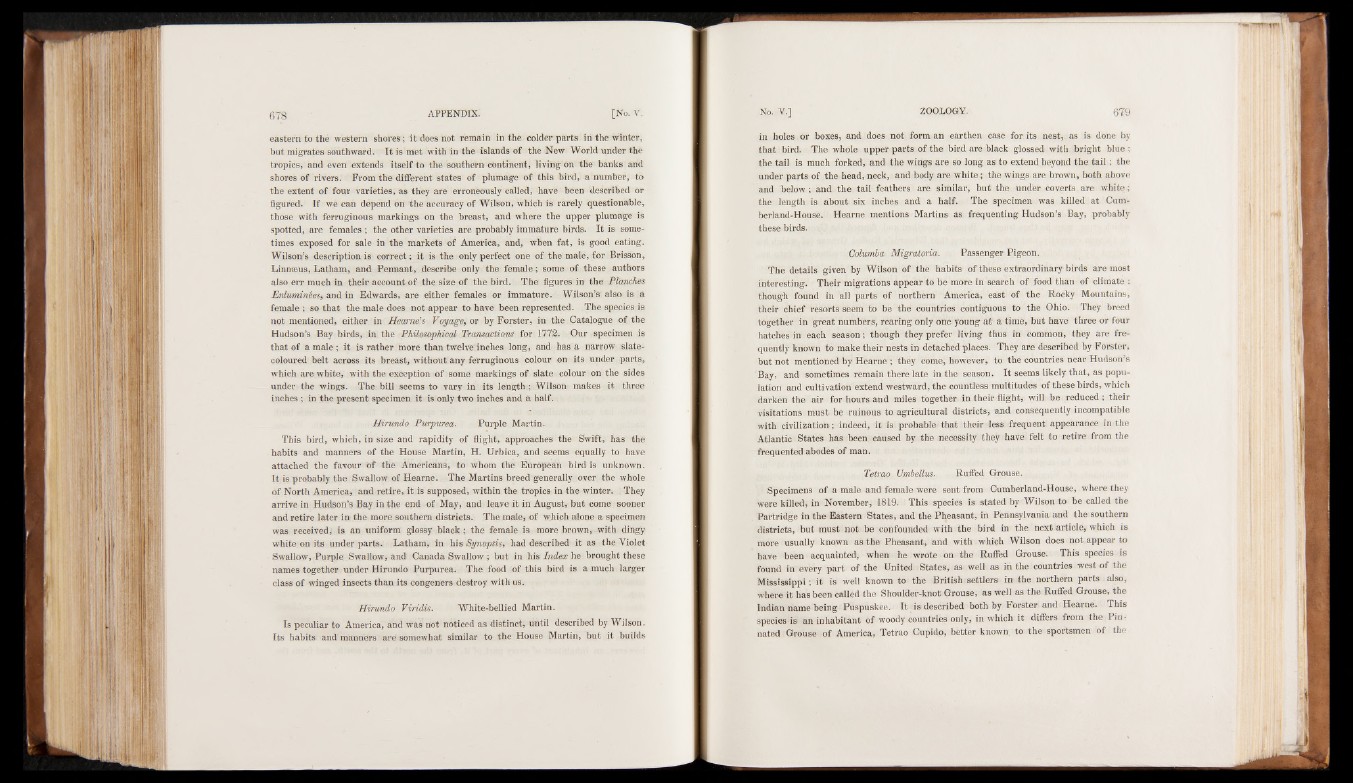
eastern to the western shores; it does not remain in the colder parts in the winter,
but migrates southward. It is met with in the islands of the New World under the
tropics, and even extends itself to the southern continent, living on the banks and
shores of rivers. From the different states of plumage of this bird, a number, to
the extent of four varieties, as they are erroneously called, have been described or
figured. If we can depend on the accuracy of Wilson, which is rarely questionable,
those with ferruginous markings on the breast, and where the upper plumage is
spotted, are females ; the other varieties are probably immature birds. It is sometimes
exposed for sale in the markets of America, and, when fat, is good eating.
Wilson’s description is correct; it is the only perfect one of the male, for Brisson,
Linnaeus, Latham, and Pennant, describe only the female; some of these authors
also err much in their account of the size of the bird. The figures in the Planches
Enluminees, and in Edwards, are either females or immature. Wilson’s' also is a
female ; so that the male does not appear to have been represented. The species is
not mentioned, either in Heame's Voyage, or by Forster, in the Catalogue of the
Hudson’s Bay birds, in the Philosophical Transactions for 1772. Our specimen is
that of a male; it is rather more than twelve inches long, and has a narrow slate-
coloured belt across its breast, without any ferruginous colour on its under parts,
which are white, with the exception of some markings of slate colour on the sides
under the wings. The bill seems to vary in its length; Wilson makes it three
inches; in the present specimen it is only two inches and a half.
Hirundo Purpurea. Purple Martin.
This bird, which, in size and rapidity of flight, approaches the Swift, has the
habits and manners of the House Martin, H. Urbica, and seems equally to have
attached the favour Of the Americans, to whom the European bird is unknown.
It is probably the Swallow of Hearne. The Martins breed generally over the whole
of North America, and retire, it is supposed, within the tropics in the winter. They
arrive in Hudson’s Bay in the end of May, and leave it in August* but come sooner
and retire later in the more southern districts. The male, of which alone a specimen
was received* is an uniform glossy black; the female is more brown, with dingy
white on its under parts. Latham, in his Synopsis, had described it as the Violet
Swallow, Purple Swallow, and Canada Swallow ; but in his Index he brought these
names together under Hirundo Purpurea. The food of this bird is a much larger
class of winged insects than its congeners destroy with us.
Hirundo Viridis. White-bellied Martin.
Is peculiar to America, and was not noticed as distinct, until described by Wilson.
Its habits and manners are somewhat similar to the House Martin, but it builds
in holes or boxes, and does not form an earthen case for its nest, as is done by
that bird. The whole upper parts of the bird are black glossed with bright blue ;
the tail is much forked, and the wings are so long as to extend beyond the tail ; the
under parts of the head, neck, and body are white; the wings are brown, both above
and below ; and the tail feathers are similar, but the under coverts are white;
the length is about six inches and a half. The specimen was killed at Cumberland
House. Hearne mentions Martins as frequenting Hudson’s Bay, probably
these birds.
Columba Migratoria. Passenger Pigeon.
The details given by Wilson of the habits of these extraordinary birds are most
interesting. Their migrations appear to be more in search of food than of climate ;
though found in all parts of northern America, east of the Rocky Mountains,
their chief resorts seem to be the countries contiguous to the Ohio. They breed
together in great numbers, rearing only one young at a time, but have three or four
hatches in each season; though they prefer living thus in common, they are frequently
known to make their nests in detached places. They are described by Forster,
but not mentioned by Hearne ; they come, however, to the countries near Hudson’s
Bay, and sometimes remain there late in the season. It seems likely that, as population
and cultivation extend westward, the countless multitudes of these birds, which
darken the air for hours and miles together in their flight, will be reduced ; their
visitations must be ruinous to agricultural districts* and consequently incompatible
with civilization ; indeed, it is probable that their less frequent appearance in the
Atlantic States has been caused by the necessity they have felt to retire from the
frequented abodes of man.
Tetrao Umbellus. Ruffed Grouse.
Specimens of a male and female were sent from Cumberland-House, where they
were killed, in November, 1819. This species is stated by Wilson to be called the
Partridge in the Eastern States, and the Pheasant, in Pennsylvania and the southern
districts, but must not be confounded with the bird in the next article, which is
more usually known as the Pheasant, and with which Wilson does not appear to
have been acquainted, when he wrote on the Ruffed Grouse. This species is
found in every part of the United States, as well as in the countries west of the
Mississippi; it is well known to the British settlers in the northern parts also,
where it has been called the Shoulder-knot Grouse, as well as the Ruffed Grouse, the
Indian name being Puspuskee. It is described both by Forster and Hearne. This
species is an inhabitant of woody countries only, in which it differs from the Pinnated
Grouse of America, Tetrao Cupido, better known to the sportsmen of the